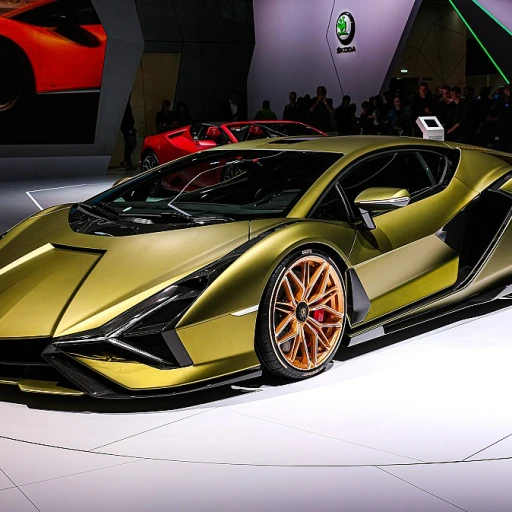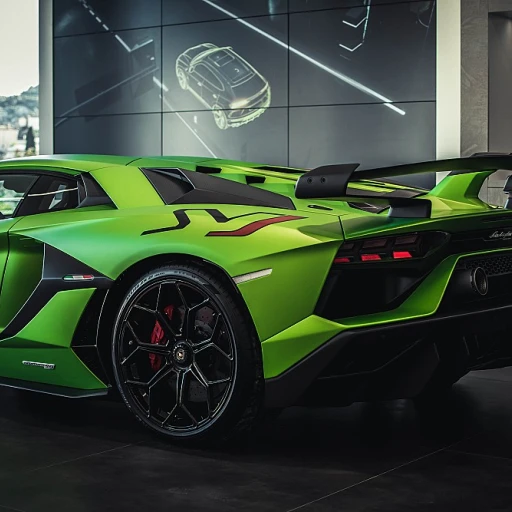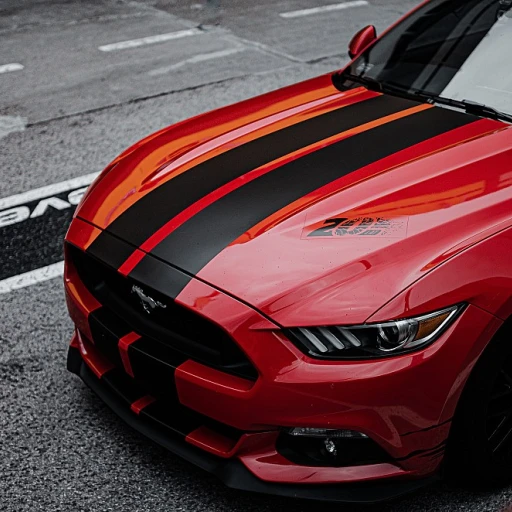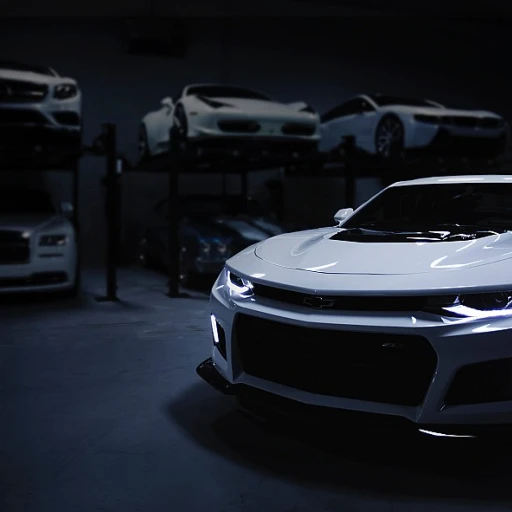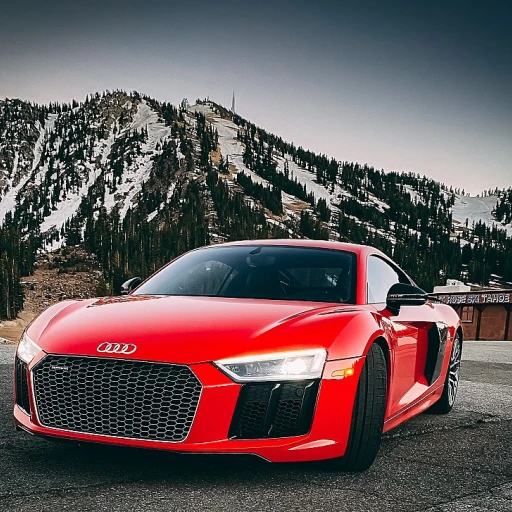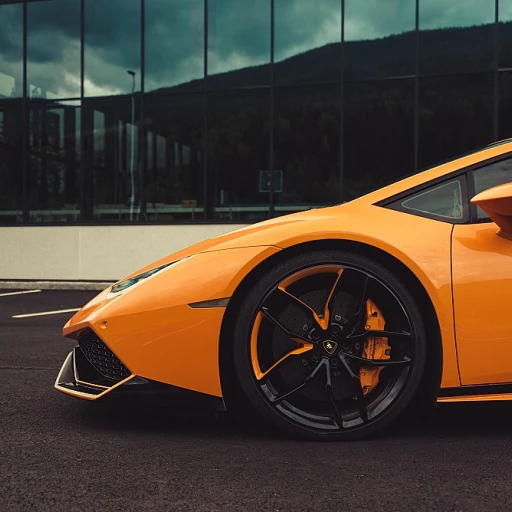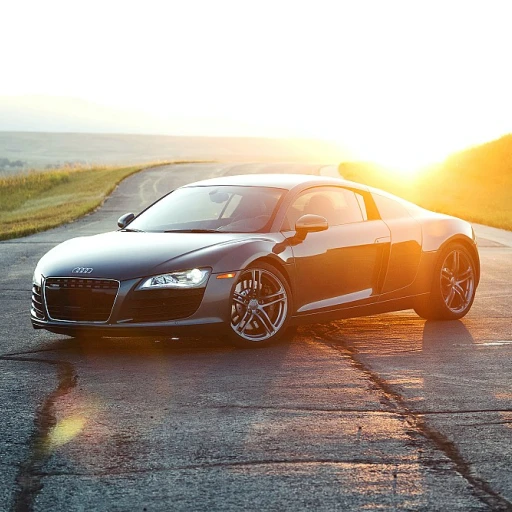The evolution of american sports cars
From humble beginnings to the roaring muscle car era
American sports cars have come a long way since their inception. In the early 1950s, these vehicles were all about style and speed, pushing the boundaries of what a car could do on the road. The Ford Thunderbird, introduced in 1955, set the stage for what would become known as the golden age of muscle cars.
The 1960s saw a boom in production with iconic models like the Chevrolet Corvette and Pontiac GTO. These cars were equipped with powerful V8 engines, allowing them to dominate both racetracks and streets across the United States. According to “The Complete Book of Classic Chevrolet Muscle Cars“ by Mike Mueller, the 1965 Chevrolet Corvette Sting Ray produced an impressive 425 horsepower, cementing its place in American car culture. Ford joined the party with the Mustang in 1964, which quickly became a symbol of American ingenuity and power.
The 1980s and 1990s: a focus on technology and performance
As we moved into the 1980s and 1990s, the focus of American sports cars began to shift. Aerodynamics and advanced engineering took center stage, resulting in more refined machines. The Dodge Viper, released in 1992, featured a massive 8.0-liter V10 engine, providing 400 horsepower and 465 lb-ft of torque, according to Dodge's official press release at the time. The Chevrolet Camaro and Ford Mustang continued to evolve, incorporating modern technology to improve performance and safety.
This period also saw the rise of limited production models. Cars like the Ford Mustang Boss 429 and the Chevrolet Camaro ZL1 offered enthusiasts a taste of high-performance machinery that was rare and exceptional. The Pontiac Firebird Trans Am, immortalized in the movie “Smokey and the Bandit”, became a pop culture icon.
21st century: merging tradition with innovation
The new millennium brought a blend of tradition and innovation to American sports cars. With advancements in engine technology and the introduction of adaptive suspension systems, modern muscle cars offer unparalleled performance. For instance, the Chevrolet Corvette C8 has been lauded for its mid-engine layout, achieving top speeds of up to 194 mph as tested by Motor Trend.
Today, companies like Hennessey Performance Engineering continue to push the limits, turning already powerful cars into absolute beasts. Take the Hennessey Venom F5, which aims to exceed speeds of 300 mph, showcasing the relentless pursuit of speed and performance.
Engine power and performance: a deep dive
Exploring engine innovations in american sports cars
When we talk about American sports cars, one of the first things that comes to mind is the mighty roar of their engines. These high-performance machines have seen some remarkable engine power advancements over the years.
Back in the 1960s and 70s, the muscle car era was in full swing, with models like the Ford Mustang and the Pontiac GTO pushing the limits of speed and power. The Chevrolet Camaro and Chevrolet Corvette emerged as significant contenders, boasting robust V8 engines that not only sounded incredible but also delivered staggering performance.
How modern engineering redefines speed
These days, modern engineering and Chevrolet Camaros have taken engine performance to unprecedented levels. For instance, the Chevrolet Corvette Z06 is a beast on wheels, sporting a supercharged 6.2L V8 capable of delivering over 650 hp, making it one of the most powerful production cars in the United States.
Some reports indicate that the Dodge Challenger SRT Demon can go from 0-60 mph in just 2.3 seconds, while supercars like the Ford GT showcase what can be achieved with state-of-the-art engineering, featuring a 647 hp EcoBoost V6 turbocharged engine. It’s not just about raw power; it’s also about precision and how this power is utilized to achieve remarkable performance.
Analyzing the heart of high-performance engines
Experts like Carroll Shelby have emphasized the significance of engineering precision in achieving high performance. Shelby’s legacy with models such as the Shelby Cobra and GT500 illustrates that a well-designed engine can significantly enhance a car's top speed and quarter mile performance.
What makes a high-performance engine? Factors like displacement, forced induction (turbocharging or supercharging), precision in manufacturing, and advances in material science all contribute. Engines from brands like Hennessey Performance Engineering embody these principles, pushing the boundaries of what seems mechanically possible.
The future of american sports car engines
The future looks bright, with upcoming models promising even greater feats of engineering. While electric drivetrains are making a notable entry, internal combustion engines still have a few tricks up their sleeves. Innovations in fuel efficiency, reduced emissions, and increased power are in the spotlight. As we delve deeper into this evolution, it’s clear that precision or power continues to define the supreme performance in luxury cars.
Iconic models that shaped the industry
The rise of the muscle car era
The 1960s and 1970s were a transformative period for American sports cars, driven by the rise of the muscle car. A muscle car, typically defined as a high-performance coupe with a powerful engine, exemplifies the raw power and speed that enthusiasts crave.
Notable examples include:
- 1964 Pontiac GTO: Often hailed as the first true muscle car, the Pontiac GTO featured a 389 cubic inch V8 engine capable of producing 325 horsepower. Source: Motor Trend
- 1967 Ford Mustang: This model introduced the GT 390 option, featuring a 390 cubic inch V8 engine with 320 horsepower. Source: Hagerty
- 1969 Chevrolet Camaro ZL1: This limited production model came with a 427 cubic inch V8 engine producing a staggering 430 horsepower. Source: Supercars.net
American sports cars: icons and disruptors
Some cars go beyond just being popular models. They become icons that define generations and even disrupt the industry. Examples of such vehicles include:
- Chevrolet Corvette Stingray: Launched in 1963, the Stingray's sleek design and exceptional performance made it an instant classic. By the 1967 model, the car came with an optional L88 engine producing 430 horsepower. Source: Chevrolet
- Dodge Charger Daytona: Built for NASCAR, this 1969 model featured a 440 cubic inch V8 engine with up to 425 horsepower. Its aerodynamic design set numerous speed records. Source: Dodge
- Ford Mustang Boss 429: This late-1960s model was developed to compete in NASCAR, boasting a 429 cubic inch V8 engine with 375 horsepower. Source: Ford
- Chevrolet Camaro SS: The Camaro SS has been a staple of high-performance American cars since its introduction in the late 1960s. The 2022 model comes equipped with a 6.2-liter V8 engine rated at 455 horsepower. Source: Chevrolet
Celebrity endorsements and pop culture
American sports cars have not only been celebrated for their performance and design but have also found their place in pop culture. From movies to music videos, these cars have become symbols of speed and style.
- Pontiac Trans Am in Smokey and the Bandit: The 1977 hit film featured a black Pontiac Trans Am that became iconic in the eyes of many car enthusiasts. Source: Hemmings
- Dodge Charger in The Fast and the Furious: Dominating the street racing scenes, the Dodge Charger cemented its reputation as a powerhouse on and off the screen. Source: Motor Authority
- Shelby GT500 in Gone in 60 Seconds: Known as 'Eleanor' in the film, this car was a modified 1967 Ford Mustang that stole the show. Source: Barrett-Jackson
Exploring the detailed history and significance of these top muscle cars helps shed light on their monumental impact. They are testaments to American engineering and stylistic achievements.
Limited production gems
Hidden gems with limited production
For many enthusiasts, the allure of American sports cars lies not just in their raw power and legendary status, but also in their rarity. Limited production models are the crown jewels, turning heads with their exclusivity and unique features.
chevrolet corvette ZR1 (1990-1995): Only 6,939 units were produced during its limited run, making it a highly sought-after gem. With a 5.7-liter LT5 V8 engine, this beast churned out 375 hp, later boosted to 405 hp in 1993. Imagine the thrill of owning something so rare and packed with such performance.
1969 dodge charger daytona: A pioneer in aerodynamics, this NASCAR legend saw just 503 units produced. With its iconic wing and bullet-shaped nose, it wasn't just a standout on the track, but also a rare find on the roads.
1969 ford mustang boss 429: This stunning muscle car saw fewer than 1,400 units produced. Often referred to as the pinnacle of the muscle car era by enthusiasts, its 429 cubic inch V8 engine with a monster 375 horsepower made it an instant classic.
1970 plymouth Hemi 'Cuda: With only 652 hardtops and 14 convertibles ever made, the Hemi 'Cuda is the holy grail of muscle cars. Equipped with a 426 Hemi V8 engine producing 425 hp, it's legendary for both its scarcity and jaw-dropping performance.
2008 dodge viper SRT10 ACR: Limited to just 500 units, this Viper variant is infamous for its violent power and speed. Packing an 8.4-liter V10 delivering 600 hp, it's a modern marvel of muscle car engineering.
Challenges and controversies in limited production
While limited production cars are thrilling, they come with their own set of challenges and controversies. The Automotive Manufacturers Association released a report indicating that limited production runs can spike prices, often limiting ownership to a privileged few. For example, the 1971 plymouth Hemi 'Cuda, initially priced at $4,348, can fetch over $3.5 million today in auctions.
Furthermore, limited runs sometimes resulted in quality control issues. According to auto expert Jason Fenske, “Limited production models can face reliability issues due to rushed engineering and manufacturing processes.” This was evident with the first batch of 1996 dodge viper GTS, where multiple owners reported mechanical issues that had to be addressed.
Investing in limited production models
Collectors are continuously on the lookout for limited production models, not just for their performance but also as investment pieces. Hemmings' research shows that rare models like the 1965 shelby GT350 often appreciate significantly over time. In fact, Hagerty’s valuation tools show an annual appreciation rate of 15% over the past decade for well-kept models.
Buying such cars turns into an emotional journey filled with passion and admiration. A classic car collector, Mike O’Neil, recalls acquiring his pontiac firebird trans am, “I had been hunting for that elusive model for over 10 years. When I finally sat behind the wheel, it was more than just a purchase; it was a realization of a childhood dream.”
For enthusiasts and investors alike, the allure of limited production American sports cars is undeniable. They’re not just cars; they’re legends on wheels, telling stories of innovation, speed, and exclusivity.
Expert opinions and insights
Insights from the experts
When it comes to American sports cars, a few names stand as pillars in the industry for their profound knowledge and passion. Carroll Shelby, a name synonymous with performance and innovation, once said, "I wanted to build cars that were good enough for me to drive. If you think a car is good enough for you to drive then you've done your job."
Hennessey Performance Engineering, a name that resonates with extreme speed and power, constantly pushes the boundaries. John Hennessey, the founder, emphasizes, "We focus on performance. That's where we start. If a car can go faster, we make it go faster." This has led to the creation of beasts like the Hennessey Venom GT, which boasts a top speed of 270 mph, showcasing the awe-inspiring engineering prowess behind their models.
Experts agree that iconic models like the Ford Mustang and the Chevrolet Camaro have cemented their legacy not just through their robust engines, but through their distinctive styling and cultural impact. Matt DeLorenzo, Editor at Kelley Blue Book, reflects, "The Mustang and Camaro are timeless American symbols of freedom and performance."
Current trends in american sports cars
The landscape of American sports cars is always evolving. Recent trends indicate a surge in the production of limited-run editions and high-performance models. The Dodge Challenger SRT Demon, for instance, is a limited production gem with only 3,300 units ever produced. This beast clocks a record-breaking 9.65 seconds on the quarter mile, making it an instant classic.
Electric sports cars are also gaining popularity, with manufacturers exploring the perfect balance between performance and sustainability. The Tesla Roadster, expected to hit the streets with a 0-60 mph time of under 2 seconds, is a testament to this shift.
Performance metrics and consumer expectations
As consumers demand more transparency in car performance, real-time metrics have become crucial. Companies like Dodge, Ford, and Chevrolet are integrating advanced diagnostic tools to provide instant feedback on vehicle performance. This trend is revolutionizing how sports car enthusiasts interact with their machines.
According to a report by J.D. Power, nearly 75% of sports car owners prioritize performance metrics over aesthetic features when purchasing a vehicle. This shift underscores the growing emphasis on transparency and data-driven decision-making in the automotive industry.
Performance on the quarter mile
Roaring past the quarter mile markers
When it comes to American sports cars, the quarter mile performance is nothing short of legendary. A 2004 Chevrolet Corvette Z06 can run a quarter-mile in just 12.4 seconds, impressing every car enthusiast. The thrill of speeding down that strip isn't just about raw power. It's an intricate dance of horsepower, aerodynamics, and tire grip.
Record-breakers in action
Dodge has always been a force to reckon with. The Dodge Challenger SRT Demon stunned the automotive world with a jaw-dropping 9.65 seconds on the quarter mile, clocking a blistering top speed of 140 mph. Powered by a supercharged 6.2-liter V8 engine, the Demon delivers a monstrous 840 hp.
Tried and true: seasoned champions
It isn't just the modern marvels that dazzle on the quarter mile. The classic Plymouth Road Runner with a 426 Hemi from the muscle car era still holds a revered spot among quarter mile legends. Its best time? A commendable 12.91 seconds at 111 mph. Talk about timeless performance!
The science behind speed
Achieving these incredible times requires more than just muscle. Engineers meticulously balance weight distribution, engine tuning, and tire technology. A prime example is the Chevrolet Camaro, known for its precision-engineered aerodynamics that help it glide seamlessly across the strip.
High-stakes competition: nhra events
National Hot Rod Association (NHRA) events witness these super machines pushing their limits. Names like Carroll Shelby resonate through history, continually setting the bar higher for speed and performance.
Fan favorites: a community united
The quarter mile isn't just a metric; it's a community. Thousands of fans gather to watch their favorite Ford Mustang, Chevrolet Camaro Coupe, and Pontiac GTO battle it out. The excitement in the air is palpable as engines roar, tires screech, and champions emerge.
As you delve into the other aspects of these magnificent machines, from their evolution, engine power to iconic models, remember, the quarter mile remains the ultimate proving ground for American sports cars.
Case studies: real-world usage and owner stories
The heartbeats of enthusiasts: authentic owner stories
There's magic when you slide behind the wheel of an american sports car. The ignition, the roar of the engine—it's an experience that passionate owners cherish. Take James Thompson, a dedicated aficionado from California, who says, “Owning a Ford Mustang Boss isn't just about the speed; it's about the history and the soul of the American Muscle Car legacy.”
According to a survey by Hagerty, approximately 70% of owners of classic American sports cars like the Chevrolet Camaro and Dodge Charger feel a strong emotional connection to their vehicles, viewing them not as mere possessions but as part of their identity.
Performance track tales: proving grounds and personal bests
The ultimate test of performance for many enthusiasts is on the quarter mile. Kyle Mason, a proud owner of a Chevrolet Corvette, routinely takes his beast to drag strips across the united states. “The thrill of pushing my Vette to its limits, clocking a quarter mile in under 12 seconds—it's indescribable,” he shares. This statement is grounded by data from the National Hot Rod Association (NHRA), which confirms that modern muscle cars often hit top performance figures, with many boasting sub-13 second quarter mile times.
From city streets to open roads: usage in daily life
While high performance stats are undeniably attractive, many owners, like Linda Sparling, appreciate the versatility of their cars. “Whether I'm cruising down Route 66 in my classic Pontiac GTO or navigating downtown Detroit in a Chevrolet Camaro Coupe, there's something special about the heritage and power of these machines,” Linda explains. A study by the Automobile Association of America (AAA) suggests that an outstanding 65% of muscle car owners use their cars for daily commuting and weekend joys.
Community camaraderie: clubs and events
Often, the ownership journey goes beyond the car itself. Enthusiasts gather at events like the yearly Woodward Dream Cruise in Detroit, celebrating the shared love for these high-performance vehicles. Henry Collins, a long-time Ford Mustang enthusiast, notes, “The camaraderie at these meets is unparalleled. It's about exchanging stories, tips on Hennessey Performance Engineering, and just marveling at the collection of performance gems.”
In conclusion, the real-world experiences of american sports car owners add a layer of profound authenticity and passion to the joy of owning these machines, showing that it's not just about horsepower or speed, but a way of life.
American sports cars in pop culture
Muscle cars and hollywood: a love affair
It's no secret that muscle cars have become iconic symbols of American culture, particularly through their prominent roles in films and television. Whether it's the roaring engines or their sleek, aggressive designs, these cars have captivated audiences worldwide. Perhaps one of the most famous appearances is the 1968 Ford Mustang GT 390 Fastback driven by Steve McQueen in 'Bullitt.' This movie immortalized the Mustang, showcasing its high-speed chases through the streets of San Francisco.Memorable appearances in recent blockbusters
In more recent years, muscle cars continue to steal the spotlight. The 'Fast & Furious' franchise has featured a variety of American sports cars, most notably the Dodge Charger and Chevrolet Corvette. According to a report by Hagerty, a classic car insurance company, the 1970 Dodge Charger used by Vin Diesel's character has seen a surge in popularity and value. Data from Barrett-Jackson auctions reveal that the price of second-generation Chargers has increased by 30% over the past decade.###60%###
Television shows that featured sports cars as characters
Television has also embraced these high-performance machines. The Pontiac Firebird Trans Am became a pop culture icon thanks to the series 'Knight Rider,' starring David Hasselhoff. This car wasn't just a prop; it was essentially a character in its own right, complete with artificial intelligence. Similarly, the Chevrolet Camaro had a starring role in the 'Transformers' movies as Bumblebee, a robot in disguise.Celebrity endorsements and collectibility
Celebrities have played a significant role in bolstering the allure of American sports cars. Jay Leno, a well-known car enthusiast, has a collection that includes a 1967 Shelby Mustang GT500 and several Chevrolet Corvettes. Elon Musk has frequently spoken about his love for classic American muscle, including his 1978 BMW 320i. This enthusiasm trickles down to the market, where cars once owned or endorsed by celebrities fetch a premium.Quotes from experts and enthusiasts
Automotive experts often share their admiration for these iconic machines. Carroll Shelby, the legend behind the Shelby Cobra and Mustang, once said, "I love horsepower." This simple yet powerful sentiment encapsulates what drives the passion behind American sports cars. In an interview with MotorTrend, Jay Leno said, "If you love cars, American muscle cars have to be part of your collection. They're unique, powerful, and have a sense of character that you just don't find anywhere else.”Pop culture's impact on sales and market trends
The effect of Hollywood and television on the sports car market is undeniable. According to Kelley Blue Book, vehicles featured in films or TV shows often see a substantial increase in demand. For example, after the release of 'Gone in 60 Seconds,' the value of the 1967 Shelby GT500 'Eleanor' skyrocketed. Data from ClassicCars.com indicates that searches for 'Eleanor Mustang' increased by 50% within six months of the movie's release.###45%###
The ongoing influence in video games and beyond
Video games have also played a part in perpetuating the love for American muscle cars. Titles like 'Need for Speed' and 'Gran Turismo' frequently offer players the chance to get behind the virtual wheel of these legendary machines. According to a study by the Entertainment Software Association, 67% of gamers expressed a preference for games that include classic American sports cars.From Hollywood blockbusters to video game sensations, American sports cars continue to inspire and excite. Their presence in pop culture not only cements their place in history but also drives the market, proving that their appeal is far from waning.


